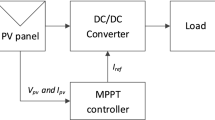Abstract
To produce maximum output power in a solar collector system, a maximum power point tracker (MPPT) is considered a vital component in system design. Though, due to partial shading effect initiated by dynamic weather conditions, the tracking process becomes more complex when locating the global maximum power point (GMPP). To solve this issue, an innovative and adaptive MPPT based on sequential Monte Carlo is suggested to accurately and efficiently predict the global peak under rapid changing weather conditions. The proposed method adaptively predicts the next best duty cycle value that will generate the maximum output power. The capability of the technique has been tested strongly under standard test conditions (STC) and dynamic weather conditions including random partial shading and changing irradiance and temperature input values. The new recommended technique is compared to the classical perturb and observe algorithm, in addition to the particle swarm optimization, and flower pollination tracking techniques. The simulated results illustrated dominance in accuracy and efficiency under varying environment conditions. The efficiency calculated was found to be as high as 99.89% at STC and as low as 98.58% at dynamic and random partial shading conditions. In addition, the results displayed high tracking speed in predicting the GMPP while maintaining no oscillations at the output power.



















Similar content being viewed by others
References
Eltamaly, A.M.; Abdelaziz, A.Y.: Modern Maximum Power Point Tracking Techniques for Photovoltaic Energy Systems, 1st edn. Springer, Cham (2020)
Ali, E.M.; Abdelsalam, A.K.; Youssef, K.H.; Hossam-Eldin, A.A.: An enhanced cuckoo search algorithm fitting for photovoltaic systems’ global maximum power point tracking under partial shading conditions. Energies 14, 7210 (2021). https://doi.org/10.3390/en14217210
Raj, J.C.M.; Jeyakumar, A.E.: A novel maximum power point tracking technique for photovoltaic module based on power plane analysis of I-V characteristics. IEEE Trans. Ind. Electron. 61(9), 4743–4745 (2014)
Punitha, K.; Devaraj, D.; Sakthivel, S.: Artificial neural network based modified incremental conductance algorithm for maximum power point tracking in photovoltaic system under partial shading conditions. Energy 62, 330–340 (2013)
Radjai, T.; Rahmani, L.: Implementation of a modified incremental conductance MPPT algorithm with direct control based on a fuzzy duty cycle change estimate or using dSPACE. Sol. Energy 110(3), 25–37 (2014)
Chiu, C.-S.; Fuzzy, T.-S.: Maximum power point tracking control of solar power generation systems. IEEE Trans. Energy Convers. 25(4), 1123–1132 (2010)
Sundareswaran, K.; Palani, S.: Application of a combined particle swarm optimization and perturb and observe method for MPPT in PV systems under partial shading conditions. Renew. Energy 75, 308–317 (2015)
Daraban, S.; Petreus, D.; Morel, C.: A novel MPPT (maximum power point tracking) algorithm based on a modified genetic algorithm specialized on tracking the global maximum power point in photovoltaic systems affected by partial shading. Energy 74, 374–388 (2014)
Punitha, K.; Devaraj, D.; Sakthivel, S.: Artificial neural network based modified incremental conductance algorithm for maximum power point tracking in photovoltaic system under partial shading conditions. Energy 62, 330–340 (2013)
Syafaruddin; Hiyama, K.T.: Artificial neural network-polar coordinated fuzzy controller based maximum power point tracking control under partially shaded conditions. IET Renew. Power Gener. 3(2), 239–253 (2009)
Ishaque, K.; Salam, Z.: An improved particle swarm optimization (PSO)-based MPPT for PV with reduced steady-state oscillation. IEEE Trans. Power Electron. 27(8), 3627–3638 (2012)
Ishaque, K.; Salam, Z.: A deterministic particle swarm optimization maximum power point tracker for photovoltaic system under partial shading condition. IEEE Trans. Ind. Electron. 60(8), 3195–3206 (2013)
Babu, T.S.; Rajasekar, N.; Sangeetha, K.: Modified particle swarm optimization technique based maximum power point tracking for uniform and under partial shading condition. Appl. Soft Comput. 34, 613–624 (2015)
PrasanthRam, J.; Rajasekar, N.: A novel flower pollination based global maximum power point method for solar maximum power point tracking. IEEE Trans. Power Electron. 32(11), 8486–8499 (2017). https://doi.org/10.1109/TPEL.2016.2645449
Batzelis, E.; Anagnostou, G.; Cole, I.; Betts, T.; Pal, B.: A state-space dynamic model for photovoltaic systems with full ancillary services support. IEEE Trans. Sustain. Energy 10, 1399–1409 (2018). https://doi.org/10.1109/TSTE.2018.2880082
Shiau, Jaw-Kuen.; et al.: Circuit simulation for solar power maximum power point tracking with different buck-boost converter topologies. Energies (Basel) 7(8), 5027–5046 (2014) Web.
Pires, V Fernão; Cordeiro, Armando; Foito, Daniel; Silva, J Fernando A.: Dual output and high voltage gain DC–DC converter for PV and fuel cell generators connected to DC bipolar microgrids. IEEE Access 9, 157124–157133 (2021)
Pandey, A.; Pattnaik, S.: Design and analysis of extendable switched-inductor and capacitor-divider network based high-boost DC–DC converter for solar PV application. IEEE Access 10, 66992–67007 (2022). https://doi.org/10.1109/ACCESS.2022.3185107
Arulampalam, M.S.; Maskell, S.; Gordon, N.: A tutorial on particle filters for online nonlinear/non-Gaussian Bayesian tracking. IEEE Trans. Signal Process. 50(2), 174–188 (2002)
Abdallah, A.; Nsour, A.; Zohdy, M.; Li, J.: GFSK demodulation using sequential Monte Carlo technique. IEEE Wirel. Commun. Lett. 4(6), 621–624 (2015). https://doi.org/10.1109/LWC.2015.2476460
Author information
Authors and Affiliations
Corresponding author
Supplementary Information
Below is the link to the electronic supplementary material.
Rights and permissions
Springer Nature or its licensor (e.g. a society or other partner) holds exclusive rights to this article under a publishing agreement with the author(s) or other rightsholder(s); author self-archiving of the accepted manuscript version of this article is solely governed by the terms of such publishing agreement and applicable law.
About this article
Cite this article
Odat, AS., Alzoubi, O., Shboul, B. et al. Dynamic and Adaptive Maximum Power Point Tracking Using Sequential Monte Carlo Algorithm for Photovoltaic System. Arab J Sci Eng 48, 15063–15083 (2023). https://doi.org/10.1007/s13369-023-08023-0
Received:
Accepted:
Published:
Issue Date:
DOI: https://doi.org/10.1007/s13369-023-08023-0




